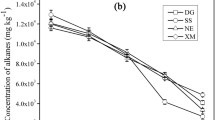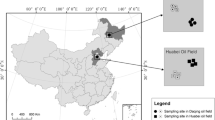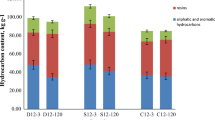Abstract
This study examined impacts of Macondo MC252 oil from the Deepwater Horizon spill on oil-degrading bacteria in fresh and oligohaline marshes dominated by the common reed Phragmites australis (Cav.) Trin. ex Steud. and correlated microbial changes to soil variables. We hypothesized that indigenous oil-degrading bacteria and soil characteristics in the marshes effectively respond to Macondo oil. We tested this hypothesis with a greenhouse mesocosm study. Weathered and emulsified Macondo oil was applied to P. australis sods at different rates (0, 4, 8, 12, and 16 L m−2). Populations of oil degrading bacteria containing alkane monooxygenase and PAH-ring hydroxylating dioxygenase alpha subunit (PAH-RHDα) genes, the expression of these genes, soil respiration rate, residual total petroleum hydrocarbon, redox potential (Eh), as well as dissolved organic carbon (DOC) and its aromaticity index of SUVA254 were measured in soils 2 months after oil addition. Oil exposure generally increased oil-degrading bacterial populations, in particular Gram-positive (GP) PAH-degraders, soil respiration rate, DOC concentration, and aromaticity of DOC, but decreased Eh values. GP PAH-RHDα genes accounted for approximately 98% of total detected genes, and expression of these genes increased by a factor of 3 to 5 at various oil dosages. Both abundance and expression of GP PAH-RHDα genes significantly correlated to SUVA254 (P < 0.05). The study revealed that indigenous oil-degrading bacteria effectively responded to weathered Macondo oil in the P. australis marsh soil wherein GP bacteria with PAH-RHDα genes played a major role in biodegradation of PAH-enriched petroleum hydrocarbons.

Similar content being viewed by others
References
Alonso-Gutiérrez, J., A. Figueras, J. Albaigés, et al., 2010. Bacterial communities from shoreline environments (Costa daMorte, Northwestern Spain) affected by the prestige oil spill. Applied and Environmental Microbiology 75: 3407–3418.
Atlas, R. M., A. Horowitz, M. Krichevsky & K. Asim, 1991. Response of microbial populations to environmental disturbance. Microbial Ecology 22: 249–256.
Baldwin, B., C. H. Nakatsu & L. Nies, 2003. Detection and enumeration of aromatic oxygenase genes by multiplex and real-time PCR. Applied Environmental Microbiology 69: 3350–3358.
Cébron, A., M. P. Norini, T. Beguiristain & C. Leyval, 2008. Real-time PCR quantification of PAH-ring hydroxylating dioxygenase (PAH-RHDα) genes from Gram positive and Gram negative bacteria in soil and sediment samples. Journal of Microbiological Methods 73: 148–159.
Cébron, A., T. Beguiristain & P. Faure, 2009. Influence of vegetation on the in site bacterial community and polycyclic aromatic hydrocarbon (PAH) degraders in aged PAH-contaminated or thermal-desorption-treated soil. Applied and Environmental Microbiology 75: 6233–6330.
Dong, W. X., C. S. Hu, S. Y. Chen & Y. M. Zhang, 2009. Tillage and residue management effects on soil carbon and CO2 emission in a wheat-corn double-cropping system. Nutrient Cycling Agroecosystems 83: 27–37.
Ellis, R. & R. J. Adams Jr., 1961. Contamination of soils by petroleum hydrodcarbons. Advanced Agronomy 13: 197–213.
Jackson, R. B., C. W. Cook, J. S. Pippen & S. M. Palmer, 2009. Increased belowground biomass and soil CO2 fluxes after a decade of carbon dioxide enrichment in a warm-temperate forest. Ecology 90: 3352–3366.
Jurelevicius, D., V. M. Vlvarez, R. Peixoto, A. S. Rosado & L. Seldin, 2012. Bacterial polycyclic aromatic hydrocarbon ring-hydroxylating dioxygenases (PAH-RHD) encoding genes in different soils from King George Bay, Antarctic Peninsula. Applied Soil Ecology 55: 1–9.
Habe, H. & T. Omori, 2003. Genetics of polycyclic aromatic hydrocarbon metabolism in diverse aerobic bacteria. Bioscience Biotechnology and Biochemistry 67: 225–243.
Hara, A., S. Baik, K. Syutsubo, et al., 2004. Cloning and functional analysis for alkB genes in Alcanivorax borkumensis SK2. Environmental Microbiology 6: 191–197.
Hamamura, N., S. H. Olson, D. M. Ward, et al., 2006. Microbial population dynamics associated with crude-oil biodegradation in diverse soils. Applied and Environmental Microbiology 72: 6316–6324.
Hazen, T. C., E. A. Dubinsky, T. Z. DeSantis, et al., 2010. Deep-sea oil plume enriches indigenous oil-degrading bacteria. Science 330: 201. https://doi.org/10.1126/science.1195979.
Judy, C. R., S. A. Graham, Q. X. Lin, A. X. Hou & I. A. Mendelssohn, 2014. Impacts of Macondo oil from Deepwater horizon spill on the growth response of the common reed Phragmitesaustralis: a mesocosm study. Marine Pollution Bulletin 79: 69–76.
Kloos, K., J. C. Munch & M. Schloter, 2006. A new method for the detection of alkane-monooxygenase homologous genes (alkB) in soils based on PCR-hybridization. Journal of Microbiological Methods 66: 486–496.
Kostka, J. E., O. Prakash, W. A. Overholt, et al., 2011. Hydrocarbon-degrading bacteria and the bacterial community response in Gulf of Mexico Beach Sands impacted by the deepwater horizon oil spill. Applied and Environmental Microbiology 77: 7962–7974.
Lin, Q. & I. A. Mendelssohn, 1996. A comparative investigation of the effects of Louisiana crude oil on the vegetation of fresh, brackish, and salt marsh. Marine Pollution Bulletin 32: 202–209.
Li, X. L., G. B. Liu, S. Xue & M. X. Xue, 2007. Effects of crude oil on growth of plant seedling and soil respiration in Loess Hilly region of North Shaanxi. Journal of Soil and Water Conservation 21(3): 95–98. (in Chinese).
Llangovan, K. & M. Vivekanandan, 1992. Effect of oil pollution on soil respiration and growth of Vigna mungo (L.) Hepper. Science of the Total Environment 116: 187–194.
Louvel, B., A. Cébron & C. Leyval, 2011. Root excudates affect phenanthrene biodegradation, bacterial community and functional gene expression in sand microcosms. International Biodeterioration and Biodegradation 65: 947–953.
Lu, X. Y., T. Zhang, et al., 2011. Bacteria-mediated PAH degradation in soil and sediment. Applied Microbiology and Biotechnology 89: 1357–1371.
Ma, Y. F., L. Wang & Z. Z. Shao, 2006. Pseudomonas, the dominant polycyclic aromatic hydrocarbon-degrading bacteria isolated from Antarctic soils and the role of large plasmids in horizontal gene transfer. Environmental Microbiology 8: 455–465.
Margesin, R., D. Labbé, F. Schinner, et al., 2003. Characterization of hydrocarbon-degrading microbial populations in contaminated and pristine alpine soils. Applied and Environmental Microbilogy 69: 3085–3092.
Muangchinda, C., R. Pansri, W. Wongwongsee & O. Pinyakong, 2013. Assessment of polycyclic aromatic hydrocarbon biodegradation potential in mangrove sediment from Don Hoi Lot, Samut Songkram province, Thailand. Journal of Applied Microbiology 114: 1311–1324.
National Commission on the BP Deepwater Horizon Oil Spill and Offshore Drilling. Deep Water: The Gulf Oil Disaster and the Future of Offshore Drilling, Report to the President, January 2011. Government Printing office: 392 pp. (http://www.oilspillcommission.gov).
Nie, M., X. D. Zhang & J. Q. Wang, 2009. Rhizosphere effects on soil bacterial abundance and diversity in the Yellow River Deltaic ecosystem as influenced by pertroleum contamination and soil salinization. Soil Biology and Biochemistry 41: 2535–2542.
Nie, M., Q. Yang, L. F. Jiang, C. M. Fang, J. K. Chen & B. Li, 2010. Do plants modulate biomass allocation in response to petroleum pollution? Biology Letters 6: 811–814.
Paissé, S., F. Coulon, et al., 2008. Structure of bacterial communities along a hydrocarbon contamination gradient in a coastal sediment. FEMS Microbial Ecology 66: 295–305.
Paisse, S., R. Duran & F. Coulon, 2011. Are alkane hydroxylase genes (alkB) relevant to assess petroleum bioremediation processes in charonically polluted coastal sdiments? Applied Microbiology and Biotechnology 92: 835–844.
Panicker, G., N. Mojib, J. Aislabie & A. K. Bej, 2010. Detection, expression and quantitation of the biodegradative genes in Antarctic microorganisms using PCR. Antonievan Leeuwenhoek 97: 275–287.
Peichl, M., T. Moore, M. Arain, et al., 2007. Concentrations and fluxes of dissolved organic carbon in an age-sequence of white pine forests in Southern Ontario, Canada. Biogeochemistry 86: 1–17.
Platts Oilgram News/OPR Extra. June 15, 2010. http://www.platts.com/IM.Platts.Content.InsightAnalysis/NewsFeature/2010/oilspill/20100615.Pdf.
Powell, S. M., S. H. Ferguson, J. P. Bowman & I. Snape, 2006. Using real-time pcr to assess changes in the hydrocarbon-degrading microbial community in Antarctic soil during bioremediation. Microbial Ecology 52: 523–532.
Qiao, J. L., L. Wang, Y. S. Tang, Y. H. Hu & J. W. Jia, 2012. Distribution and characteristics of total petroleum hydrocarbons in Jiuduansha tidal wetland and their potential impact on soil microbial respiration. Journal of Environmental Science and Health, Part A 47(2): 319–325.
Redmond, M. C. & D. L. Valentine, 2012. Natural gas and temperature structured a microbial community response to the deepwater horizon oil spill. PNAS 109: 20292–20297.
Romero, I. S., P. T. Schwing, G. R. Brooks, et al., 2015. Hydrocarbons in deep-sea sediments following the 2010 Deepwate Horizon Blowout in the Northeast Gulf of Mexico. PLoS ONE 10(5): e0128371. https://doi.org/10.1371/journal.pone.0128371.
Sotsk, Y. J. B., C. W. Greer & R. M. Atlas, 1994. Frequency of genes in aromatic and aliphatic hydrocarbon biodegradation pathways within bacterial populations from Alaskan sediments. Canadian Journal of Microbiology 40: 981–985.
Teepe, R., R. Brumme & F. Beese, 2001. Nitrous oxide emissions from soil during freezing and thawing periods. Soil Biology and Biochemistry 33: 1269–1275.
Van Beilen, J. B., M. G. Wubbolts & B. Witholt, 1994. Genetics of alkane oxidation by Pseudomonas olevorans. Biodegradation 5: 161–174.
Van Beilen, J. B., S. Panke, S. Lucchini, et al., 2001. Analysis of Pseudomonas putida alkane degradation gene clusters and flanking insertion sequences: evolution and regulation of the alk genes. Microbiology 147: 1621–1630.
Van Beilen, J. B., F. Mourlane, M. A. Seeger, et al., 2003. Cloning of Baeyer-Villigermonooxygenases from Comamonas, Xanthobacter and Rhodococcus using polymerase chain reaction with highly degenerate primers. Environmental Microbiology 5: 174–182.
Van Beilen, J. B., E. G. Funhoff, A. van Loon, et al., 2006. Cytochrome P450 alkane hydroxylases of the CYP153family are common in alkane-degrading eubacteria lacking integral membrane alkane hydroxylases. Applied and Environmental Microbiology 72: 59–65.
Wang, Q. R., X. M. Liu, Y. S. Cui & Y. T. Dong, 2001. Concept and advances of applied bioremediation for organic pollutants in soil and water. Acta Ecologica Sinica 21(1): 159–163.
Wasmund, K., K. A. Burns, I. Kurtböke & D. G. Bourne, 2009. Novel alkane hydroxylase gene (alkB) diversity in sediments associated with hydrocarbon seeps in the Timor sea, Australia. Applied and Environmental Microbiology 75: 7391–7398.
Weishaar, J., G. Aiken, B. Bergamaschi, M. Fram, R. Fujii & K. Moppers, 2003. Evaluation of specific ultraviolet absorbance as an indicator of the chemical composition and reactivity of dissolved organic carbon. Environmental Science and Technology 37: 4702–4708.
Whyte, L. G., T. H. M. Smits, D. Labbe, et al., 2002. Gene cloning and characterization of multiple alkane hydroxylase systems in Rhodococcus strains Q15 and NRRL B-16531. Applied and Environmental Microbiology 68: 5933–5942.
Yergeau, E., M. Arbour & R. Brousseau, 2009. Microarray and real-time PCR analyses of the response of high-arctic soil bacteria to hydrocarbon pollution and bioremediation treatments. Applied and Environmental Microbiology 75: 6258–6267.
Zhuang, W. Q., J. H. Tay, A. M. Maszenan, L. R. Krumholz & S. T. Tay, 2003. Importance of Gram-positive naphthalene-degrading bacteria in oil contaminated tropical marine sediments. Letters in Applied Microbiology 36: 251–257.
Acknowledgements
This research was made possible by grants from The Gulf of Mexico Research Initiative (GoMRI), BP/GoMRI through the Northern Gulf Institute, and National Natural Science Foundation of China (No. 41671105; 41603068). We thank Kristopher Nolan Ackoury for laboratory assistance.
Author information
Authors and Affiliations
Corresponding author
Additional information
Guest editors: Shuqing An, Jennifer Ann Davis & Dong Xie / Coastal Wetlands: Services, Uses and Conservation
Rights and permissions
About this article
Cite this article
Wang, J., Judy, C.R. & Hou, A. The responses of indigenous oil-degrading bacteria to oil exposure in Phragmites australis-dominated marsh soil: a mesocosm study. Hydrobiologia 827, 65–74 (2019). https://doi.org/10.1007/s10750-017-3461-3
Received:
Revised:
Accepted:
Published:
Issue Date:
DOI: https://doi.org/10.1007/s10750-017-3461-3




